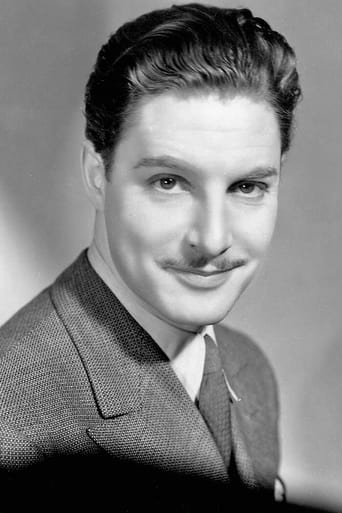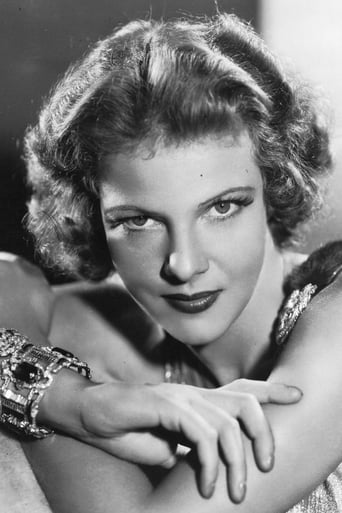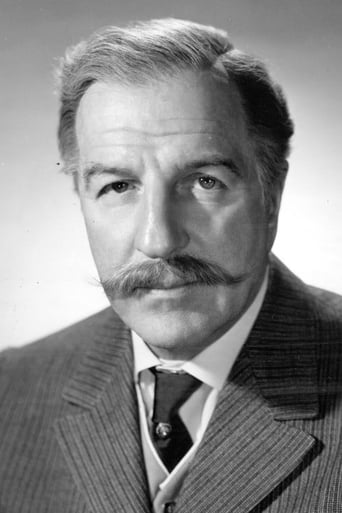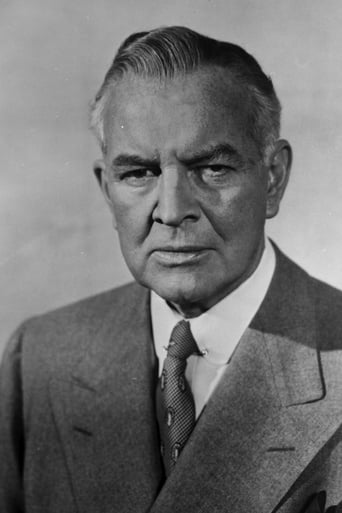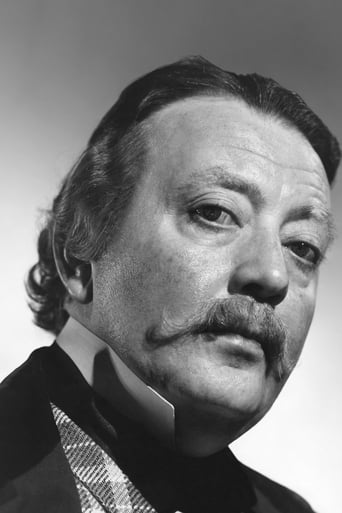Nonureva
Really Surprised!
Smartorhypo
Highly Overrated But Still Good
Philippa
All of these films share one commonality, that being a kind of emotional center that humanizes a cast of monsters.
Raymond Sierra
The film may be flawed, but its message is not.
vincentlynch-moonoi
I'm not often a fan of British movies, so it was with some surprise that I found myself rather liking this one. It turns out this is actually an American film, with Robert Donat being imported as its star.One thing I liked about this film was the appearance of a number of character actors with whom I was more familiar in their much later roles. I've always enjoyed Louis Calhern, and this is, perhaps, the earliest film in which I've seen him (although he dates back to the silent era). I also rather like Sidney Blackmer, and this is the earliest film in which I've seen him ("Heidi" with Shirley Temple was a bit later). And Raymond Walburn, who we usually see as a comic buffoon, is here one of the villains.I appreciate Robert Donat much more after watching this film, although he was less believable as a young sailor early in the film than he was as the Count Of Monte Cristo later in the film.Elissa Landi, an actress with whom I was not familiar, was not very impressive here as the female lead. In some small way...the way in which she pouted with her mouth...was very distracting (or should I say just down right poor acting).This is a story of revenge, and a darned good one. Highly recommended, and perhaps deserving of a spot on your DVD shelf.
vitaleralphlouis
People who are impressed with 2010's boring and bloated movies might do better with the 2002 version, but persons who enjoy quality movies will take the trouble necessary to locate a VHS copy of this great 1934 classic. Hint: Rare VHS tapes are listed on Ebay.I first saw this in its theatrical re-release in the 1940's paired with Man in the Iron Mask. It's been reissued several times and played on TV numerous times in the 1950's. Edward Small knew how to make this kind of picture. The 118 minute length was unusual back then, but the story moves along at a fast clip. In the 1940's I was a kid and had traveled to New York and no-place else. Since then I've been to Europe many times. Now I can appreciate the attention to detail of the numerous sets, be it prison or royal apartments. But the important thing is the story and the acting. Excellent.The VHS is the colorized version. It looks fine in color, or you can tone down the color and see it as originally made. This movie has made money for 76 years and might someday be issued in DVD. Compare that to the El Stinko movies of 2010 which are usually dead within 6 weeks.Quality is forever.
pitcairn89
I echo all the other reviewers in saying that this is a very well-done and entertaining movie. Robert Donat was an excellent actor, and he carries this role very well. He may have won his Oscar for Mr. Chips, but I have always liked him in this movie, and in Hitchcock's "The Thirty-Nine Steps," even more. And Elissa Landi- she was incredibly gorgeous, and a good actress, too. Producer Edward Small must have had a thing for Dumas and swashbucklers. He also produced the 1939 "Man in the Iron Mask," and the 1940 "Son of Monte Cristo." As many people know, Donat was slated to play "Captain Blood" in 1935, but for whatever reason dropped out, and that part went to the unknown Errol Flynn. Flynn's star-making performance catapulted him to the top, and led to the string of classic swashbucklers he made throughout the 30s and 40s. Interesting in that Donat's "Monte Cristo" kick-started a dormant film genre, and his withdrawal from "Captain Blood" introduced the man who would re-invent, and re-invigorate, the whole swashbuckler genre. So perhaps Donat and Flynn can be considered the godfathers of the sound film's action movie (and the inheritors of Douglas Fairbanks, Sr.'s mantle). I was also struck by a similarity between some scenes in this, and in the James Whale film, "The Bride of Frankenstein," made just a year later, in 1935. Another reviewer on this site has noted the same thing, and I agree with him completely. Dantes' fellow prisoner, played by O.P. Heggie, is a character very similar to the blind hermit in "Bride," played by- O.P. Heggie. The blind hermit befriends Boris Karloff's lonely monster, in much the same way that this prisoner befriends a lonely Edmund Dantes. Some of the dialogue is quite similar. And, in a particularly dramatic scene between Dantes and his friend, "Ave Maria" is played on the soundtrack. If all of you remember, when the blind hermit meets the monster, and thanks God for bringing him a friend, "Ave Maria" is used on the soundtrack, to very great emotional effect. I read that James Whale actively sought O.P. Heggie to play this part, so one has to wonder if it is just a coincidence, or a conscious plan- I find the former possibility a little implausible. As the other reviewer on this site noted, it may have been a sly in-joke on Whale's part (and not only that- Heggie was an excellent actor, and brought great humanity to these two parts. So Whale's choice was also artistically sound). He was a director who loved in-jokes, and his films are full of humorous and sly references to all kinds of things. You also have to wonder if anyone at the time picked up on it. We can see these films back-to-back now, and notice similarities, courtesy of DVDs and TV, but in the 30s, there would have been a yearlong gap between the showings of these films. I imagine most moviegoers wouldn't have remembered that Heggie had played in the earlier film, or seen the similarities. I hadn't noticed myself, on previous viewings of "Count," but became aware of it just last night. The use of "Ave Maria" made it seem conclusive, to me. Whale also used Douglas Walton in "Bride," as Percy Shelley, and I wonder if he liked the actor in his part as Landi's son, in "Count." Interestingly, Whale directed Edward Small's "The Man in the Iron Mask" in 1939. That same year, Rowland V. Lee, who directed "Count," took over from Whale, and directed "Son of Frankenstein" (and then Lee directed "Son of Monte Cristo" the following year. A bit confusing!). Boy, Hollywood was filled with all kinds of connections. Six Degrees of Monte Cristo!Anyway, just some interesting sidelights to two great films. For fans of both movies, take a look at them.
Igenlode Wordsmith
The good news is that this turns out to be, as I hoped it might, my "long-lost Monte Cristo" -- the film I once caught the end of, thanks to the BBC, on holiday twenty years ago, and have never been able to find again since. The bad news is that, alas, the part I missed then isn't actually nearly so good as the remainder...The Reliance Pictures production of "Count of Monte Cristo" is a queer mixture of success and banality; of studio polish and poverty-row shortcuts; of efficient editing and crass musical indirection; of genuine emotional power and thumping cliché; of briskly-moving adaptation and bizarre moments of staging (revolving witness-box, anybody?) A literal version of Dumas it is not -- one would not expect it from any film spectacular of this period -- but many of the changes made are entertaining or effective, and the happy ending provided works at least as well as Dumas' rather unsatisfactory version. The meandering original is reduced to a bare two hours' running time by dint of concise scripting and cutting out most of the sub-plots involving the de Villefort and Morrel families, an attempt which is by and large successful. It works less well at the beginning, where there are simply too many unidentified characters popping up and scheming without any of them really being established properly, particularly as Morrel and de Villefort's father are then pruned from the plot, never to appear again. And de Villefort's downfall as presented here really doesn't work for me: lacking the damning evidence of infanticide, the script doesn't seem to come up with any terribly convincing alternative to turn the tables on the prosecutor. On the other hand, introduced material such as Mercedes' (completely uncanonical) aristocratic snob of a mother, or the tableaux in praise of Fernand at which Haydee accuses him, works very well.Ironically -- given the Hollywood studio's doubts as to their unknown English import's ability to pull off anything but a fresh-faced lead -- Robert Donat shines mainly in the latter half of the picture as the older, embittered and sophisticated Monte Cristo. His guileless Dantes makes little impression, for it could be any generic juvenile lead role -- the character as written is not so much naive as uninteresting. Donat fares better where he can give a sense of some hidden depths to the part, and his best features are his strong eyes and brows rather than his cheery grin. As Monte Cristo, however, he is both debonair and dangerous, an intelligent schemer with a dry wit at his enemies' unknowing expense, and he is supported ably by both Douglas Walton as the young Albert and Elissa Landi as Mercedes.It was Miss Landi's performance with which I was truly impressed here; she ages with utter conviction from the wilful girl to the resolute mother, and lends her scenes opposite Donat the real impact that is lacking from so much of the film. In a plot that has been re-angled to concentrate far more closely on the Edmond/Mercedes relationship, her role is vital, and her character provides most of the emotional engagement of the story, from light-hearted charm to heartbreak (Valentine de Villefort, here paired off with Albert, is a mere cypher in comparison).The film starts off in outright formulaic guise, from Napoleon's appearance (in full uniform and cocked hat, with his hand duly thrust in his breast 'like that') to the standard storm-at-sea sequence with water poured across the screen. It continues to suffer from crude musical underlining more or less throughout, almost sabotaging for example Donat's scene with the dying Abbe Faria, which he otherwise pulls off with conviction, while certain characters, such as Morrel and the mute Nubian Ali, appear to have been retained despite the loss of the plot elements which actually involved them (possibly as a result of cuts to the script later in filming?) Overall, however, the adaptation does a pretty good job of conveying information quickly and concisely -- Albert's entire Italian adventure is dealt with effectively in a matter of a few minutes with none of the essentials lost, and Haydee's brief role introduced without any seeming contrivance. It borrows little in practice from Dumas' wordy original save the bare outlines of its plot, and sometimes not even those; but as an initially uninspired Hollywood screen adaptation it improves considerably as it goes on. Literary fidelity isn't everything, and if it were not let down by certain sections I would have rated it considerably higher; alas, this production remains an odd mixture of the powerful and the pedestrian.

